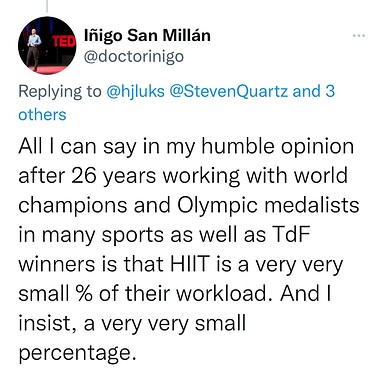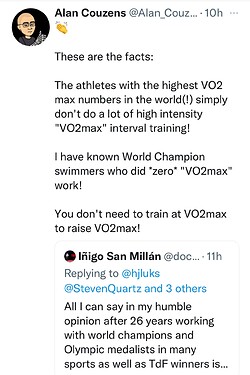I just found this! What do you think?
" I am not sure how valuable this information is to this thread, but I was actually tested in Inigo San Millan’s lab here in Denver at the Anschutz performance center back in 2016. You simply paid some money, did a few tests, and were prescribed a training schedule. I was a 35-year-old runner at the time and had never tested any of these metrics despite having a solid running career. I was thinking about training for a fast half marathon. I started cycling in 2019 but had no concept of cycling when I went to his lab. I only did the VO2 max test, but along the way, my zones were calculated based on fat vs carbs. I don’t remember much about the general conversation other than being told not to barf in the mask, but I still have my lab report and prescribed training. I was given 3 prescribed zones: Zone 1-2, Zone 3, & Zone 4+ My max HR was 193. My zone 1-2 was 153-162, Zone 3 168-171, and zone 4+ 180+. Again, this is running not cycling.
A few interesting notes from each zone:
Zone 1-2: Recovery and Base endurance. This is from rest up to your aerobic threshold. This is where your body is most efficient at metabolizing fat for energy.
- Zone 1-2 days should be a gradual increase up to the top workload and heart rate in the zone
- This is your recovery or easy zone
Zone 3: Threshold and Tempo. This is just before your lactate or anaerobic threshold and is typical (sic) the race pace for endurance events. Here is where you build tolerance to exercise.
- Always start with your specific warm-up it’s designed to enhance fat utilization.
- Stay at AT/Zone 2 workload for the entire interval.
- If the Zone workload is giving HRs above the top of zone 2 or below the bottom, report back to your coach.
Zone 4-5 Peak or Anaerobic training zone, it is not an all-out sprint. This is where you improve your peak VO2 and burn the highest calories
- Always start with your specific warm-up it’s designed to enhance fat utilization.
- Zone 5+ or Peak VO2 workouts must stay at Zone 5+ workload and HRs for intervals should be zone 3 and above.
It also suggests strength training days where you complete the specific warm-up before strength routine and do strength training 2x per week. No actual lifting or strength program was ever discussed that I remember.
The Warm-Up Page. Lots of notes here. My specific warm-up was starting at an HR of 143 with 2-minute intervals increasing it to 171 over 10 minutes (143, 152, 159, 163, 171). I was given treadmill speeds for each 2 minutes. Notes on the page:
- Warm-up should be performed on all Zone 3 and 4-5 training days. After your warm-up, take a 3-5 min easy recovery. On your Zone 1 days use the first 8-10 minutes to slowly warm-up.
- If your heart rate after warming up is + or - 4 PBM, please notify your coach. (This was underlined!)
- If at any time you feel like your workouts are too easy do not increase speeds unless you have spoken with your coach. We are teaching your body to favor fat and spare glycogen at the highest speed possible, speeding up to soon will decrease your results.
I was given 4 weeks of training. All included 3 days of base building with one day as long aerobic. Plus a VO2 max day and a Threshold day. In order of each week the workouts were:
VO2 Max:
- 10 sets of 2 minutes (180+)
- 11 sets of 2 minutes (180+)
- 7 sets of 3 minutes (180+)
- 10 sets of 2 minutes (180+)
Threshold:
- 6 sets of 5 minutes, 1:15 rest (168-171)
- 7 sets of 5 minutes, 1:15 rest (168-171)
- 3 sets of 6 minutes, 4 sets of 5 minutes, 1:15 rest (168-171)
- 2 sets of 7 minutes, 3 sets of 6 minutes, 1:15 rest (168-171)
Zone 1-2:
- Simply prescribed time. 2 days at 50 minutes (Running) and one long day at 70 minutes. All HR between 153-162)
Okay, long post, but as it pertains to this thread, this is straight from ISM himself. Although, it’s 5 years old and things could have changed.
I did a DFA a1 ramp test with a Polar H10 and AI endurance and sure enough, my AET came out at 157 BPM on the bike. My anaerobic threshold according to AI endurance was 174 BPM. I have a ramp test FTP of 272w as of December (old I know). My endurance celiing cluster on AI endurance shows 228w and 157 BPM which right now for 60-90 minutes I’ll be right around that probably drifting to the low 160s. I did a ride with a 10 min warm up and a set 215w for an hour and my HR drifted from about 150 BPM to 156 BPM over that time.
I am not an expert. Just trying to provide some hopefully interesting data and information. I think the big take away for me is that this upper zone 2 is closer to what most standard metrics consider tempo. I am also curious that the HR +/- 4 BPM is a concern. Most of my reading suggest HR zones can be 10-15 BPM and it’s no big deal but according to this a small difference is meaningful.
In general, my anecdotal experience is that this all lines up. I can hold 173 BPM for about an hour when throwing down a big climb. I have done 2+ hour rides averaging 150 BPM while it’s an effort, not soul-crushing, and somewhere around 180+ I start to see god (turning 40 much more so)."



 .
.
